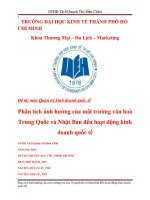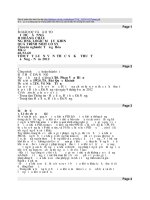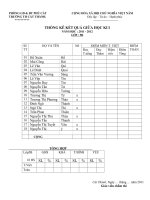UBI-GM-Presentation14.050112-place pps
Bạn đang xem bản rút gọn của tài liệu. Xem và tải ngay bản đầy đủ của tài liệu tại đây (3.26 MB, 26 trang )
International Marketing Channels
Chapter 14
McGraw-Hill/Irwin © 2005 The McGraw-Hill Companies, Inc. All rights reserved.
PowerPoint presentation prepared by:
Alfred Lowey-Ball
Associate Professor of Marketing
UBI-United Business Institutes
Brussels, Belgium
Chapter Outline
•
Doublemint in China
•
Channel of distribution structures
•
Import oriented
•
Japanese
•
From traditional to modern structures
•
Distribution patterns
•
General
•
Retail
•
Alternative middlemen choices
•
Home-country
•
Foreign-country
•
Government-affiliate
•
Factors afecting choice of channel
•
Cost Coverage
•
Capital Character
•
Control Continuity
•
Locating, selecting & motivating middlemen
•
Doublemint in China
•
Channel of distribution structures
•
Import oriented
•
Japanese
•
From traditional to modern structures
•
Distribution patterns
•
General
•
Retail
•
Alternative middlemen choices
•
Home-country
•
Foreign-country
•
Government-affiliate
•
Factors afecting choice of channel
•
Cost Coverage
•
Capital Character
•
Control Continuity
•
Locating, selecting & motivating middlemen
Chapter Learning Objectives
1. The variety of distribution channels and how they
affect cost and efficiency in marketing
1. The variety of distribution channels and how they
affect cost and efficiency in marketing
2. The Japanese distribution structure and what it
means to Japanese customers and to competing
importers of goods
2. The Japanese distribution structure and what it
means to Japanese customers and to competing
importers of goods
3. How distribution patterns affect the various aspects
of international marketing
3. How distribution patterns affect the various aspects
of international marketing
4. The growing importance of e-commerce as a
distribution alternative
4. The growing importance of e-commerce as a
distribution alternative
5. The functions, advantages, and disadvantages of
various kinds of middlemen
5. The functions, advantages, and disadvantages of
various kinds of middlemen
6. The importance of middlemen to a product’s
success and the importance of selecting and
maintaining middlemen
6. The importance of middlemen to a product’s
success and the importance of selecting and
maintaining middlemen
Introduction
•
Getting the product to the target market can be costly
•
Forging an appropriate channel of distribution is one of
the most critical tasks facing the international firms
•
Each market contains a distribution network with many
channel choices whose structures are unique and in the
ST fixed
•
In some markets the distribution structure is multi-
layered, complex, and inefficient.
•
Competitive advantage will go to the marketer with the
most cost effective channel
Channel-of-Distribution Structures
•
The distribution process includes the physical handling and
distribution of goods, the passage of ownership (title), and the
buying and selling negotiations among producers, middlemen
and customers
•
Each country market has a unique distribution channel
structure
•
Within these structures are a variety of middlemen whose
customary functions, activities, and services reflect existing
competition, market characteristics, traditions and economic
development
•
Channel structures range from those with little developed
infrastructure such as those found in many emerging markets
to the highly complex, multi-layered system found in Japan
Import-oriented distribution structure
1. Seller’s market, little consumer choice
2. Distribution systems local rather than
national in scope
3. Marketing infrastructure—warehousing,
ad agencies, mkt research—is non-existent
because importer does it all.
•
The importer controls a fixed amount of goods from abroad and
the distribution system developed around the philosophy of a
seller’s market dedicated to a few affluent customers.
•
The importer controls a fixed amount of goods from abroad and
the distribution system developed around the philosophy of a
seller’s market dedicated to a few affluent customers.
Japanese Distribution Structure
1. a structure dominated by many small
middlemen dealing with many small
retailers—high density of middlemen
2. channel control by manufacturers,
3. a business philosophy shaped by a unique
culture, and
4. laws that protect the foundation of the
system—the small retailer
•
The Japanese distribution system is quite different from that in
the US or EU, with following four distinguishing features:
•
The Japanese distribution system is quite different from that in
the US or EU, with following four distinguishing features:
Japanese vs US distribution
McGraw-Hill/Irwin © 2005 The McGraw-Hill Companies, Inc. All rights reserved.
•
MITSUKOSHI, a giant upscale department store,
founded in 1611, high quality, broad choice of
products, provides a total life style experience to
shoppers
•
Provides a total life experience: « i-shoku-ju » to
shoppers
•
Pricey, together with the small neighborhood retailer
and supporting distribution networks controls
retailing in Japan
•
Sales declining, new discount stores are entering the
market, dealing directly with the manufacturers
Will Mitsukoshi survive in its present form??
MITSUKOSHI in Japan
Comparison of Retail Structures
Trends: Traditional to modern channel structures
1. Pressure from within and without to create
more efficent distribution and retail systems
2. In EU Mergers & alliances to create a
response to US super retailers
3. Introduction of US-style efficiencies in mass
buying, close inventory control, broad
product offerings, fast service everywhere
4. Influence of the internet:
1. Home retailing (“El Corte Ingles”)
2. Joint buying (GM, Ford, DaimlerChrysler)
3. The challenge of goods delivery use of
convenience stores in Japan
Distribution Patterns
1. Middlemen Services
2. Product Line Breadth
3. Costs and Margins
4. Channel Length
5. Nonexistent Channels
6. Blocked Channels
7. Stocking
8. Power and Competition
•
Distribution patterns remain quite different throughout the
world and they are continually evolving…
•
Distribution patterns remain quite different throughout the
world and they are continually evolving…
1. Retail Size Patterns
2. Direct Marketing
3. Resistance to Change
4. Alternative Middleman Choices
•
International retailing shows even greater diversity in its
structure than does wholesaling
•
International retailing shows even greater diversity in its
structure than does wholesaling
Some general retailing patterns include:
Some general retailing patterns include:
Retail Structures in some countries
International Distribution alternatives
Home-Country Middlemen
1. Manufacturers’ Retail Stores:
Disney, Benneton, Zara
2. Global Retailers: Ikea,
Carrefour, Wal-Mart
3. Export Management Companies
4. Trading Companies: esp. J.
ITOSHU, Mitsubishi, Marubeni
5. U.S. Export Trading Companies
6. Complementary Marketers
7. Manufacturer’s Export Agent
•
Home-country middlemen provide marketing services from a
domestic base and find foreign markets for products for local
manufacturers
•
Home-country middlemen provide marketing services from a
domestic base and find foreign markets for products for local
manufacturers
Frequently used types of domestic intermediaries include:
Frequently used types of domestic intermediaries include:
8. Home-Country Brokers
9. Buying Offices
10. Selling Groups
11. Webb-Pomerene Export Associations
12. Foreign Sales Corporation
13. Export Merchants
14. Export Jobbers
Export Management Companies
Characteristics of Domestic Middlemen
Foreign-Country Middlemen
1. Manufacturer’s Representatives—esp
for distribution of industrial goods
2. Distributors
3. Foreign-Country Brokers
4. Managing Agents and Compradors
5. Dealers
6. Import Jobbers, Wholesalers, and
Retailers
•
Foreign middlemen bring the manufacturer closer to end-use
markets. Some of the more important foreign-country
middlemen, who find markets for foreign manufacturers
include:
•
Foreign middlemen bring the manufacturer closer to end-use
markets. Some of the more important foreign-country
middlemen, who find markets for foreign manufacturers
include:
Characteristics Foreign country middlemen
Factors Affecting Choice of Channels
1. Identify specific target markets within and across
countries.
2. Specify marketing goals in terms of volume, market
share, and profit margin requirements.
3. Specify financial and personnel commitments to the
development of international distribution.
4. Identify control, length of channels, terms of sale,
and channel ownership
Discussion points with potential intermediaries:
Discussion points with potential intermediaries:
Six Cs of Channel Strategy
1. Cost
2. Capital Requirements
3. Control
4. Coverage
5. Character
6. Continuity
Channel strategy is influenced by the following six factors:
Channel strategy is influenced by the following six factors:
Locating Middlemen
1. Commercially published directories
2. Foreign consulates
3. Chamber-of-commerce groups located abroad
4. Other manufacturers producing similar but
noncompetitive goods
5. Middlemen associations
6. Business publications
7. Management consultants
8. U.S. Department of Commerce
Firms seeking overseas representation should compile a list of middlemen from
such sources as the following:
Firms seeking overseas representation should compile a list of middlemen from
such sources as the following:
Selecting Middlemen
1. Selection criteria:
(a) reputation
(b) creditworthiness
(c) markets served
(d) products carried
(e) number of stores
(f) store size
2. The Agreement details
the terms of the
contract and the
functions to be
performed on behalf of
the foreign
manufacturer
•
Exclusivity
•
Annual sales
minimum









